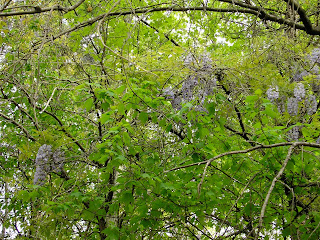First for some of the showy stuff. Right outside the front entrance of the Access National Bank building at 1800 Robert Fulton Drive these tulips (Tulipa spp.) have been now blooming for more than a week. There are more than a hundred species and countless cultivars of tulips (see this Wikipedia article), so I'm not even going to attempt to botanize these.
It is now also the season for wisteria (Wisteria spp.) to bloom, as in this specimen at the southwest corner of Sunrise Valley Drive and Cross School Road. Wisteria are highly invasive vines and are among the eight prohibited plants in Reston.
I am not really able to tell whether this is Chinese wisteria (W. sinensis - see this Virginia Tech fact sheet) or Japanese wisteria (W. floribunda - see this Virginia Tech fact sheet). The most definitive distinguishing characteristic appears to be the direction in which the vines twine, but I was not able to observe any twining.
However, it would appear that all flowers on the raceme opened at the same time, which would suggest Chinese wisteria.
In open patches of uncultivated grassland, such as this spot between Robert Fulton Drive and the W&OD bike path just north of Sunset Hills Drive, there is also a profusion of this showy yellow plant.
This is common winter cress (Barbarea vulgaris), also known as "yellow rocket" - see this Connecticut description and this Missouri one. This particular specimen was photographed in the early morning of April 20 along the W&OD bike path north of Sunrise Hills Road. Note the four-lobed flower and the sessile leaves.
Along the W&OD path one now also frequently encounters this erect, fast-growing plant with opposite, squarish leaves that closely hug the stem. This is common milkweed (Asclepias syriaca), so named for the milky sap of its main stem. See this Missouri description, this Virginia Tech weed guide, and this Wikipedia entry.
Added by edit on June 6: This is not milkweed, but rather Indian hemp (Apocynum cannabinum). Both have opposite elliptical leaves that cling to a single stem when emerging, but the Indian hemp is more gracile, with leaves spread farther apart.
In certain favored spots, such as here on the slope between Robert Fulton Drive and the W&OD bike path north of the winter cress meadow previously shown, the milkweed forms rather extensive thickets.
Along the W&OD gravel path, as here between Sunrise Valley Drive and the Dulles Toll Road, the Virginia pine (Pinus virginiana) is also spectacularly in "bloom", with the male strobili fully developed and ready to shed their pollen.
This image shows some of the new strobili adjacent to several old female cones that have long ago dropped their seeds. Note the recurved spines on each scale of the cones, which are characteristic of this species, together with the short, paired needles.









